Electric guitars can vary significantly in weight and you might be surprised by how much some guitars can weigh.
Whether you want to ship a guitar, take it on a plane, or find a guitar comfortable to play, this guide will tell you everything you need to know about the weight of electric guitars.
The average weight of an electric guitar is 8 lbs (3.6 kg). Typical electric guitars can weigh anywhere from 6 to 10+ lbs (2.7 – 4.5 kg) depending on the type of wood used and shape of the body.
Let’s look at the typical weight of different types of electric guitars, why the weight matters, and other important details you need to know about an electric guitar’s weight.
What Impacts a Guitar’s Weight
There are a couple of things that make up most of the difference in weight between electric guitars. Understanding these factors will help you better understand the guitars you are buying or own.
Type of Wood
If you pick up two identical guitars and they feel different in weight, it’s likely due to the type of wood.
Different types of wood have different densities that impact the overall weight of a guitar. If you’ve ever picked up some Balsa wood and were shocked at how light it was, you know that the type of wood makes a big difference in weight.
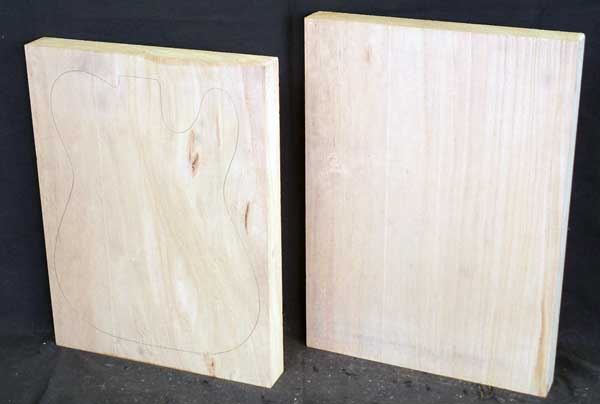
The type of wood used for the fretboard does impact weight, but it is insignificant compared to the type of wood used in the guitar body and neck.
Here are the most common types of wood used in electric guitars ranked by weight:
- Alder: 400 – 700 kg/m3
- Swamp Ash: 450 – 550 kg/m3
- Basswood: 300 – 600 kg/m3
- Mahogany: 450-640 kg/m3
- Walnut: 650 – 700 kg/m3
- Maple: 550-700 kg/m3
As you can see, there can be a massive difference between types of wood, but also within the same type of wood.
For example, Mahogany is typically thought of as a heavy type of wood and Alder is thought of as a light type of wood for guitar, but you can see that it is possible to buy Alder that weighs more than Mahogany.
The weight of a type of wood can vary depending on growing conditions and location, so keep this in mind when considering wood type.
Body Shape and Size
Take a look at the below guitars and think about which one is the heaviest and which one is the lightest:

It should be no surprise that the Strandberg (headless guitar on the right) is the lightest (by far) and the double-neck guitar on the left is the heaviest.
While those are extreme examples, the shape and size of a guitar’s body can make a big difference to a guitar’s weight.
When comparing guitars, pay close attention to the thickness of the guitar’s body.
Take a look at the below Ibanez S Series and Gibson Les Paul to get an idea how much of a difference the thickness can make:

It should be no surprise that the slim and contoured Ibanez feels ridiculously light compared to the thick and bulky Les Paul.
Body Type (Solid, Semi-Hollow, Chambering)
Take a look at the two guitars below and think about which one weighs more:
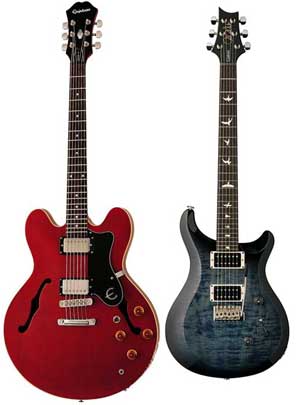
The guitar on the left is significantly larger but weighs less than the other guitar because the guitar on the left has a hollowed out body.
What about these two guitars:
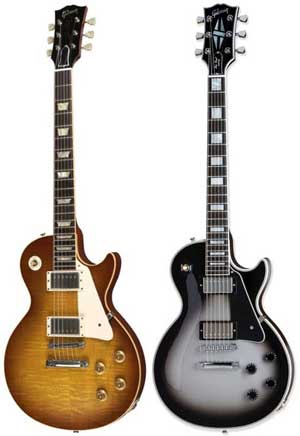
While they are both Gibson Les Pauls, one may be significantly lighter than the other depending on whether the guitar body has been chambered or not.
An important aspect of a guitar’s weight is how solid the body is. Some guitars are built with a solid slab of wood, while others have hollowed sections.
A solid body guitar uses a solid slab of wood or a few solid slabs glued together. A typical Les Paul feels heavy because it uses a solid slab of wood.
A semi-hollow body guitar has large sections of the guitar hollowed out as shown below:
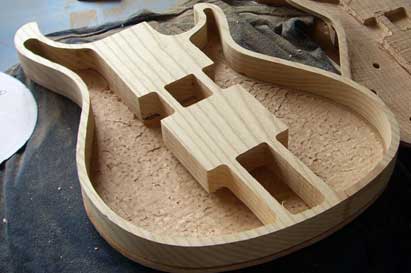
As you might imagine, hollowing out the body not only changes the way the guitar sounds, but it also significantly reduces the weight.
You can tell if a guitar is a semi-hollow body if it has ‘F-holes’ on the face of the body.
A hollow-body guitar is completely hollow on the inside apart from structural supports under the bridge and neck.
Many hollow-body guitars are large in size, but fairly light thanks to the hollow body.
Some electric guitars use chambering as a way to reduce the weight of a guitar (also called weight relief).
Chambering is when parts of a solid guitar’s body have been routed out and hidden to create empty pockets.
Sometimes this is done to change the sound of the guitar, while other times it is done purely for weight relief.
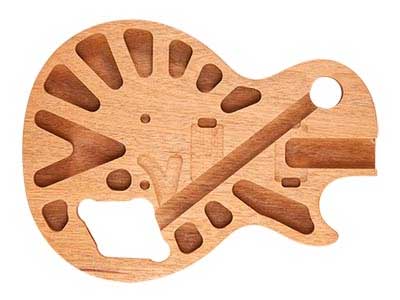
These chambers reduce the weight of a guitar as well as change the way the guitar resonates.
Gibson are well-known for using chambering in their guitars from around the 80s onwards.
You won’t be able to tell if a Les Paul has been chambered by looking at it, but you will definitely notice when you pick one up.
Examples of Electric Guitar Weight and Dimensions
When looking through these examples, remember that the type of wood used does play a big role in the weight of a guitar.
The below figures are averages and can vary if the type of guitar offers models using different woods.
Les Paul Weight
A typical Gibson Les Paul weighs between 9-12 lbs (4 – 5.5 kg).
When compared to the other types of guitars below, it should be obvious how much heavier a Les Paul can be.
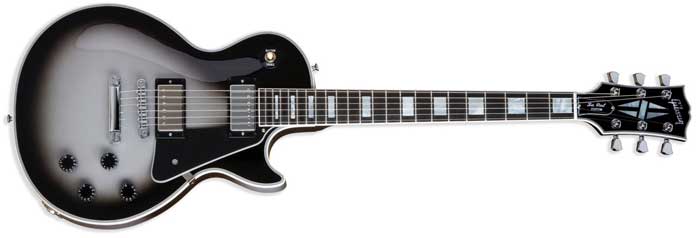
The heavy weight of a Les Paul is due to the thick body design and the use of mahogany for the body.
Some Les Pauls have cavities routed into the body to provide some weight relief. They look identical to a solid-body Les Paul but feel significantly lighter.
Stratocaster Weight
A typical Fender Stratocaster weighs around 7 – 8.5 lbs (3 – 3.8 kg).
The weight can vary as strats are often built using various woods including alder, ash, basswood, mahogany, and more.

If you play a Les Paul then pick up a Stratocaster, it will be obvious how much lighter and more comfortable it will feel.
Telecaster Weight
A typical Fender Telecaster weighs around 7 – 8 lbs (3 – 3.6 kg).

Just like strats, teles have been built with a variety of woods over the years. You are most likely to see one made alder or swamp ash, which makes it fairly lightweight.
Gibson SG Weight
A typical Gibson SG weighs around 6 lbs (2.7 kg).

SGs are made out of mahogany and are thinner than a Les Paul, which explains the big difference in weight between the two guitars.
PRS Custom 24 Weight
A PRS Custom 24 weighs around 9lbs (4 kg).
The heavy weight is due to the mahogany body with a carved maple top.

While the PRS can be just as heavy as a typical Les Paul, the contoured body style makes it feel more comfortable to play.
Ibanez JEM / RG
A typical Ibanez JEM or RG style guitar weighs between 7.5 – 8.5 lbs (3.4 – 3.8 kg).

The JEM body is typically made with basswood or alder with a maple neck. The wood used in RGs can vary as there are a lot of different woods used across RG models.
Epiphone Dot
The Epiphone Dot weighs 8 lbs (3.6 kg).
The Dot is Epiphone’s version of the classic Gibson ES-335 which weighs slightly more at 9 lbs (4 kg).
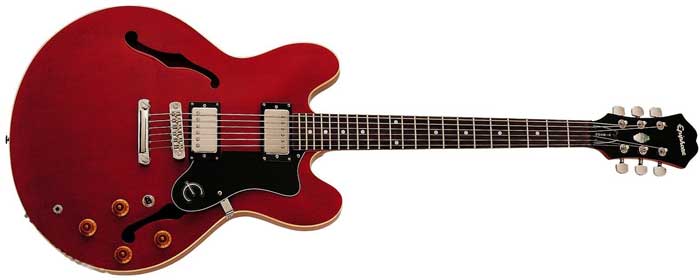
While the large body makes it look like it should be heavier than 8 lbs, it is a semi-hollow guitar.
Double-neck Gibson EDS-1275
The Gibson EDS-1275 is a double-neck guitar and weighs 13 lbs (6 kg).
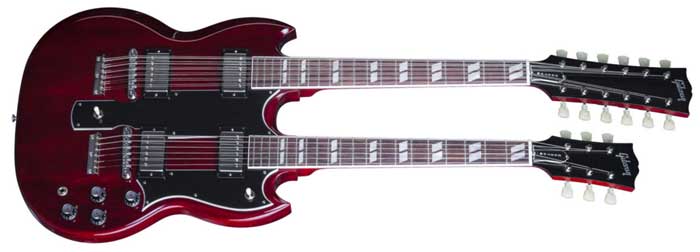
It should be no surprise that this guitar weighs significantly more than the typical guitar.
The extra weight of another neck and the larger body size makes this a beast to play while standing up.
Strandberg Boden
A Strandberg Boden weighs around 5 lbs (2.3 kg).
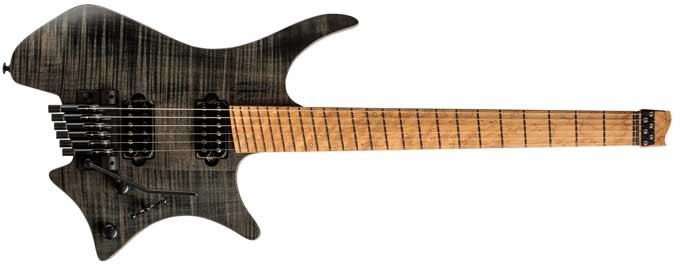
This is an extreme example of cutting the weight down by removing the headstock, having a small and contoured body, and heavily chambering the body.
When you pick up a Strandberg for the first time, the lack of weight is the first thing everybody notices. But you forget about the weight when you play it and hear how good it can sound.
Traveler Guitar
A Traveler guitar weighs 4 lbs (1.8 kg).
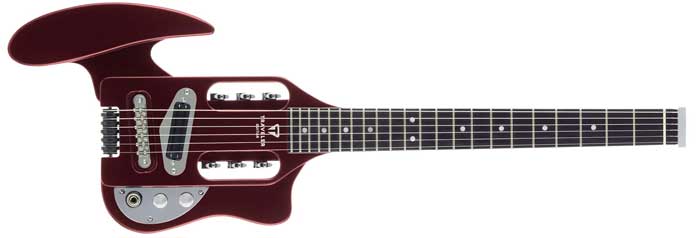
This is another extreme example as these guitars are designed to be as lightweight as possible for traveling.
If you’re looking for a lightweight guitar for traveling, check out my Guide to Travel Guitars and Accessories here.
Guitar Weight Chart
The below guitar weight chart compares the above guitars so you can see how they stack up.

As you can see, there is quite a lot of overlap between different types of guitars. Even in the same type of guitar, there can be a significant variance in weight due to the type of wood used.
The above chart shows that while the average weight of an electric guitar is 8 lbs (3.6 kg), the average doesn’t really mean anything.
Electric Guitar Case Weight
If you’re considering traveling with your guitar or shipping it, you should also consider the weight of packaging or your case.
A typical hardshell guitar case weighs between 8 – 10 lbs (3.6 – 4.5 kg).
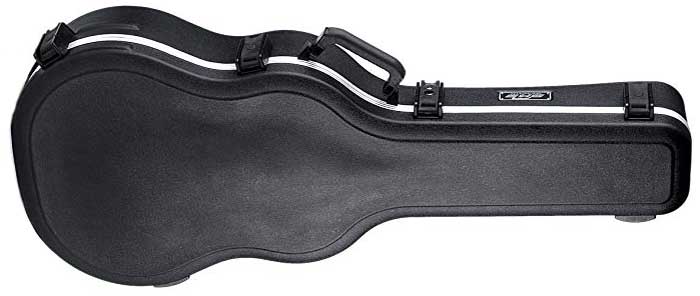
The weight of an electric guitar case can vary depending on the thickness of the shell and the materials used on the inside.
While shipping a guitar with a hard case may push your shipping costs up, it does provide the best protection for your guitar.
The alternative is to use a soft bag and use bubble wrap to give your guitar extra protection.
A typical gig bag weighs around 1 lbs (0.45 kg).
There are heavy-duty soft cases available that provide decent padding which will weigh around 2 lbs (0.9 kg).
Does a Guitar’s Weight Matter
There are a couple of reasons why a guitar’s weight matters. Some of these reasons may be important to you, while others may not be important.
If you’re looking at buying a guitar, here are a few things to consider when looking at how heavy the guitar is.
Guitar weight and comfort
Out of all of the reasons you may consider when it comes to a guitar’s weight, comfort is likely the most important to most people.
The weight of an electric guitar plays a massive role in overall comfort. A super-heavy electric guitar can give you shoulder pain when playing standing up, while a lightweight guitar won’t cause any discomfort.
If the first thing you notice when you pick up a guitar at a shop is how heavy it is, think about whether you’re happy for all of that weight to be held by your shoulder.
There are plenty of guitarists who love heavy guitars, so there is no right or wrong choice when it comes to comfort. Just remember that lighter guitars tend to feel more comfortable while playing.
Guitar weight and tone
The weight of a guitar can vary significantly. So you may wonder whether the weight of a guitar has an impact on tone.
To answer this question, you need to remember that the main difference in weight between electric guitars is the type of wood used. So does the type of wood used in a guitar affect tone?
That question causes more debates and arguments among guitarists than anything else. There are countless YouTube comparisons, heated Reddit arguments and forum threads that go on forever trying to answer that question.
Unless you want to get pulled into the ‘tonewood’ debate, I recommend you avoid thinking about it completely.
Heavier guitars and lighter guitars do tend to sound different but don’t concern yourself whether the difference in tone is caused by the weight of the guitar.
Guitar weight and sustain
The weight of a guitar does play a part in the overall sustain you hear. Denser woods impacts the resonance of your strings and can cause them to ring out longer.
If you strum the open strings on several types of electric guitars and listen to how long they ring, you will notice that heavier guitars tend to ring out longer.
This is partly why Les Paul guitars are well-known for their great sustain. There are other reasons that contribute to sustain, but the weight of the guitar plays an important role.
Heavy vs Light Guitars
If you are trying to choose between a heavy and a light guitar, let’s look at a few important points.
As explained above, the weight of a guitar impacts tone to an extent, sustain, and comfort. But it would be a mistake to only look at the weight of the guitar to decide on these points.
For example, it is generally believed that heavier guitars have better sustain. But it doesn’t take long to find a lightweight guitar with far better sustain than a Les Paul if you look for one.
The point to remember is that your decision shouldn’t really be “should I get a heavy or light guitar?”.
There is no general rule that says heavy guitars are better or light guitars are better.
Think about what is important to you in a guitar and focus on those features. If you end up with a heavy guitar, buy a suitable guitar strap as explained later. If you end up with a light guitar, that’s good too.
While many guitarists think that tone is the most important point to focus on when buying a guitar, many others would argue that playability is more important.
You can always upgrade your pickups to improve your guitar’s tone, but the playability of a guitar is fairly unchangeable (apart from changing string gauges or adjusting action).
Find a guitar that feels comfortable to play and you’ll play it more often.
How to Weigh a Guitar
If you want to ship your electric guitar or take it on a plane, you probably want to have a decent idea on how much it weighs.
As you saw earlier, there can be large differences in weight in the same type of guitar, so weighing your guitar is better than relying on averages.
You don’t need to buy a special scale to weight guitars and a typical digital bathroom scale will work fine.
To weigh your guitar on a bathroom scale, follow these steps:
- Stand on the scale and weigh yourself
- Stand on the scale again while holding your guitar and weigh yourself
- The difference between the two measurements is the weight of your guitar
This method is important because bathroom scales weren’t designed to accurately weigh objects as light as electric guitars.
As an example, if you weigh yourself and you are 160 lbs (72.5 kg) and while holding your guitar you are 167 lbs (75.7 kg), then your guitar weighs 7 lbs (3.2 kg).
You can use this method to also weigh your guitar case or packaged guitar before you ship it.
Making a Heavy Guitar Feel Comfortable
If you have a heavy guitar, there is a way you can improve how comfortable it feels while you play standing up.
All of the weight from a guitar rests on your shoulder when you play standing up. The width of the guitar strap controls how well the weight is distributed across your shoulder.
If you have a narrow guitar strap, the weight of a heavy guitar will dig into your shoulder and can easily cause pain over time.
If you get a wide guitar strap made of thick leather or padded at the shoulder, you might be surprised by how comfortable a heavy guitar suddenly becomes.
A typical guitar strap is about 2″ wide (5 cm). There are wide straps available between 3 and 4″ (7.6 – 10 cm) which can significantly improve the comfort of any guitar on your shoulder.
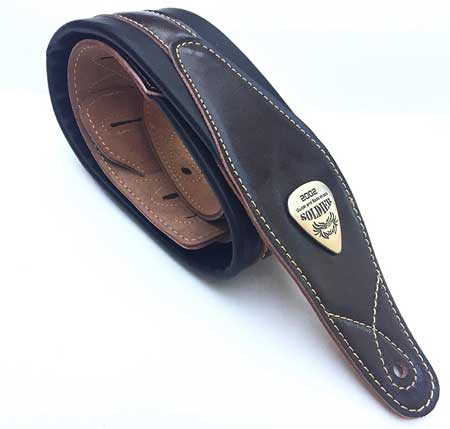
Check out this wide guitar strap (link to Amazon for different options) for a good example of what to look for if you have a heavy guitar.
A wide guitar strap will evenly distribute the weight across your shoulder and can make heavy guitars significantly more comfortable to play.
